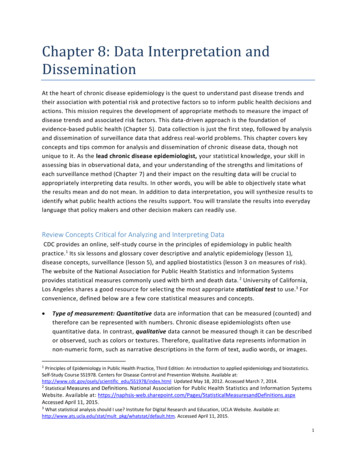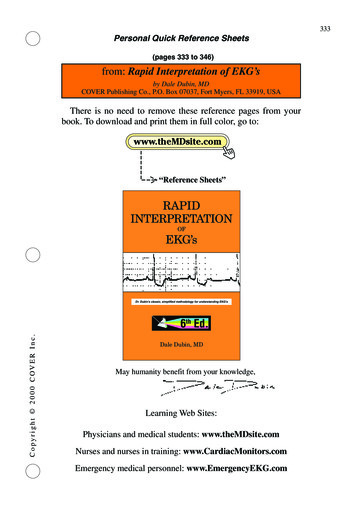
Transcription
Chapter 8: Data Interpretation andDisseminationAt the heart of chronic disease epidemiology is the quest to understand past disease trends andtheir association with potential risk and protective factors so to inform public health decisions andactions. This mission requires the development of appropriate methods to measure the impact ofdisease trends and associated risk factors. This data-driven approach is the foundation ofevidence-based public health (Chapter 5). Data collection is just the first step, followed by analysisand dissemination of surveillance data that address real-world problems. This chapter covers keyconcepts and tips common for analysis and dissemination of chronic disease data, though notunique to it. As the lead chronic disease epidemiologist, your statistical knowledge, your skill inassessing bias in observational data, and your understanding of the strengths and limitations ofeach surveillance method (Chapter 7) and their impact on the resulting data will be crucial toappropriately interpreting data results. In other words, you will be able to objectively state whatthe results mean and do not mean. In addition to data interpretation, you will synthesize resul ts toidentify what public health actions the results support. You will translate the results into everydaylanguage that policy makers and other decision makers can readily use.Review Concepts Critical for Analyzing and Interpreting DataCDC provides an online, self-study course in the principles of epidemiology in public healthpractice.1 Its six lessons and glossary cover descriptive and analytic epidemiology (lesson 1),disease concepts, surveillance (lesson 5), and applied biostatistics (lesson 3 o n measures of risk).The website of the National Association for Public Health Statistics and Information Systemsprovides statistical measures commonly used with birth and death data. 2 University of California,Los Angeles shares a good resource for selecting the most appropriate statistical test to use.3 Forconvenience, defined below are a few core statistical measures and concepts. Type of measurement: Quantitative data are information that can be measured (counted) andtherefore can be represented with numbers. Chronic disease epidemiologists often usequantitative data. In contrast, qualitative data cannot be measured though it can be describedor observed, such as colors or textures. Therefore, qualitative data represents information innon-numeric form, such as narrative descriptions in the form of text, audio words, or images.1Principles of Epidemiology in Public Health Practice, Third Edition: An introduction to applied epidemiology and biostatistics.Self-Study Course SS1978. Centers for Disease Control and Prevention Website. Available at:http://www.cdc.gov/osels/scientific edu/SS1978/index.html Updated May 18, 2012. Accessed March 7, 2014.2Statistical Measures and Definitions. National Association for Public Health Statistics and Information SystemsWebsite. Available at: alMeasuresandDefinitions.aspxAccessed April 11, 2015.3What statistical analysis should I use? Institute for Digital Research and Education, UCLA Website. Available at:http://www.ats.ucla.edu/stat/mult pkg/whatstat/default.htm. Accessed April 11, 2015.1
Examples of qualitative data more common in public health are focus group notes or answersto open-ended interview questions. Qualitative data can provide insight or context th at fills agap in the quantitative data. However, qualitative findings will not be generalizable beyond thegroup who provided the information.Measuring data quality: Two qualities of measurement necessary for understanding andinterpreting accurately data results are validity and reliability. Validity is the degree to whichthe measurement actually measures what it is intended to measure. Reliability refers to thedegree to which a measurement produces the same values when identical measurements arerepeated in the same population. If a measure is not valid, then what is being measured is notknown. If a measure is not reliable, then one cannot measure changes over time.Measuring magnitude of events or disease occurrence in a population: Incidence rate is therate of new cases of a disease or condition among a population over a defined period of time.Incidence rate is also a proportion, because the persons in the numerator are also in thedenominator. A commonly used incidence rate is a death rate from the state mortality systemof death certificates. Prevalence is the rate of existing cases of a disease, condition or behavior(e.g., tobacco use) among a population at a point in time or over a defined period of time. Themost commonly used chronic disease prevalence rates come from BRFSS. BRFSS prevalenceestimates can approximate the current (or historical) burden of a disease or risk factor in apopulation but not usually the number of new cases. Prevalence is a function of incidence andduration of a condition. Both can be used as measures of risk. Adjusted rates are rates thathave been standardized in such a way to allow for fair comparisons of rates over time oramong different populations defined by the geography where they reside. The most commonin epidemiology is age-adjusted rates, because the rate of chronic diseases increases withincreasing age. The direct method of age adjustment: Age-specific rates for a population at aparticular time and place are applied to a standard age distribution, s uch as the U.S. populationin 2000. Age-specific rates for a second population are applied to the same standard agedistribution. In effect, the two resulting artificial or hypothetical rates allow for a faircomparison, because the resulting rates are independent of the underlying age distribution ofthe population they represent.Measuring change in risk: Relative reduction is the percent change from the baseline periodcompared to the next period of interest (e.g., 50% relative decrease from a prevalen ce of 20%in 2000 to 10% in 2010). It can also be the percent change among the experimental groupcompared to the control group. It is calculated as follows:(Event Rate among Experimental Group – Event Rate among Controls) Event Rate amongControlsor(Baseline Rate – Current Rate) Baseline RateAbsolute reduction is the difference between the rate during the baseline period or among thecontrol group and the rate during the current period or among the experimenta l group (e.g.,2
10% absolute difference from the prevalence of 20% in 2000 to 10% in 2010, sometimesdescribed as a 10-point change). Examining trends is a basic analysis of surveillance data by time to detect changes in incidenceor prevalence of risk and protective factors and health outcomes. Assess if the change in risk isan artifact of an increase in population size, improved diagnostic procedures, and/or enhancedreporting and other reporting biases. Measures of association between an exposure or risk factor and a health outcome include riskratio (relative risk), rate ratio, odds ratio, and population attributable risk. An association isany observed relationship or pattern between to measured quantities. An association is notthe same as causation. 4 Risk ratio is the ratio of incidence proportions of two groups (thepercentage of persons with a disease in group one divided by the percentage of persons with adisease in a second group). The rate ratio is the ratio of incidence rates of two groups. Oddsratios provide a reasonable approximation of a risk ratio when the study design is a case control study. In a case-control study, one cannot calculate risk, because the size of thepopulation from which the cases (the persons with the outcome of interest ) is not known.Confounding is the distortion of an association between an exposure (risk factor) and a healthoutcome by a third variable related to both the exposure and the outcome. Interaction ismodification of the effect of the exposure on the outcome by a third variable. For example, therisk of mesothelioma from exposure to asbestos greater among smokers than non -smokers.Population attributable risk measures the public health impact of an association between anexposure and outcome. Also known as attributable proportion or attributable risk percent, itrepresents the expected reduction in disease if the exposure could be removed. The definitionis the difference between risks for the exposed group and unexposed group divided by the riskfor the exposed group times 100%. For example, Colorado analyzed the population attributablerisks of maternal smoking and inadequate weight gain during pregnancy on low birth weight. 5 Statistically significance is a measure of how likely a result could have occurred by chancealone, and a confidence interval is a range of values for a measure or estimate (e.g., rate orodds ratio) constructed so that the range has a specified probability of including the true valueof the measure in the population. Often the probability, which is selected in advance ofrunning the calculations, is 95 percent. For example, if an epidemiologist took 100 randomsamples from the population and each time measured obesity in the sample, 95 times out of a100, the true obesity prevalence in the population would be within the 95% confidenceinterval. If the confidence intervals for estimates (in the same population in two time periodsor two populations in the same time period) do not overlap then these two estimates arestatistically significantly different. However, this difference might not be clinically relevant or4Health Knowledge. Public Health Action Support Team Website. Available at: ation-causation 2011. Accessed February 16, 2015.5Colorado Department of Public Health and Environment. Making Progress on Tipping the Scales: Weighing in on Solutions tothe Low Birth Weight Problem in Colorado. Update 2011. Available at: hVlprWTA/edit?usp drive web&pli 1 . Accessed April 11, 2015.3
meaningful in practical terms. Also, using confidence intervals to test for statistical significanceis sometimes a conservative approach.Understand Concepts Critical for Disseminating Data ResultsThere are circumstances where you as the lead chronic disease epidemiologist cannot or shouldnot release data results. Not releasing data is referred to as “data suppression”. The two mainreasons to suppress data are: 1) to protect the confidentiality of the person or persons and 2) toprevent the use of unreliable data or low quality data. To protect confidentiality, follow theconfidentiality guidelines and data use agreements—standards established by the healthdepartment, data source, or surveillance system to protect the identity of the individuals orjurisdictions represented within the data (Chapter 6). Public health practitioners can be heldpersonally liable for not following these standards. The exact threshold for suppressio n varies inconfidentiality guidelines and might be based solely on the numerator or both the numerator andthe denominator in an analyzed table of results. For example, a confidentiality guideline couldspecify that any count in a table that is less than 5 must be suppressed, meaning deleted from thetable of results, regardless of the total count in the table or the total population the analyzedresults represent. Some guidelines further specify that if the reader can calculate the numbersuppressed from the table of results that more information must be suppressed or furtheraggregated. To prevent the use of low quality data, there are sample size guidelines—standardsestablished by the surveillance system to ensure that only representative (and reliable) data isshared. For example, the Behavioral Risk Factor Surveillance System suppresses data with anunweighted sample size of the denominator is less than 50 respondents or the relative standarderror is greater than 0.3. In addition, caution is warranted in interpreting estimates basedon cell sizes (numerators) less than 50 .Translate Data for Optimal Messaging to Your Intended AudienceFor data to effectively drive action, the data results from surveillance systems must be easy forstaff to use appropriately and easy for the public to understand. Your role is to determine theaudience(s) for the data results and their specific needs, select appropriate formats for sharing theresults, identify the key messages for each audience, and share information accordingly. You aretranslating numeric, statistical information into everyday language while also interpreting andrevealing the meaning of the results. Telling the results as a story that frames the issue and usessocial math provides the kind of everyday language that busy professionals (colleagues, policymakers) immediately grasp and will use.Frame your information to tell a storyThe London-based data-journalist and “information designer” David McCandless advises datapurveyors to “design information so it makes more sense, tells a story, and allows us to focus only4
on information that is important.”6 Answer these questions before developing your message fromthe data, a message that connects the problem, solution, values, and action. What story do the data tell? What problem and solution, if any, do the data suggest? What is your end game? What question were you trying to answer with the data analysis?What is your call to action? Who is your audience? What do they value? What is their context? What decisions arethey facing? Numeracy or statistical literacy of the audience? Can they translate percentages andrates? If not, the data will need to be presented as simply as possible, in a clear languagewith compelling context and visual displays of the results that would tell the same story, ifthe words were removed. What is your understanding of the concept and meaning, not justthe tool of data analysis and the recipe for calculating a rate? Do you understand theconcept well enough to tell it simply?Use social math and framing to help tell your storySocial math is “the practice of translating statistics and other data so they become interesting tothe journalist and meaningful to the audience.” 7 As outlined in CDC’s Framing Guide forCommunicating about Injury, there are several steps for creating social math and a compellingstory:81. Consider the message frame. For example, CDC’s frame for those who work in the field of injuryis “We want a society where people can live to their full potential.” This frame is a value that youand the audience have in common. When selecting a frame, consider what you want to accomplishand whether you can make interesting connections, comparisons or metaphors.2. Make a strong and dramatic statement of the problem. Select relevant examples appropriate for the target audience. Make the statistic meaningful to the audience. It can be effective to break data down bytime (e.g., 400,000 deaths per year) and by place to localize the information as much aspossible. However, do not provide a long list of statistics about the problem. People wantto know about the solutions, what they cost, and how they will get done. Find useful comparison statistics, such as a statistic about a familiar thing. For example,compare the daily individual cost of a program to the cost of a daily latte coffee. Thecomparison can be dramatic or unusual. However, avoid invalid, unfair comparisons.6Information is Beautiful. David McCandless Website. Available at: http://www.informationisbeautiful.net/about/ AccessedMarch 7, 2014.7Dorfman L, Woodruff K, Herbert K, Ervice J. Making the Case for Early Care and Education: A Message Development Guide forAdvocates, pp. 112-114. Berkeley, CA: Berkeley Media Studies Group, 2004. Available at:www.bmsg.org/documents/YellowBookrev.pdf Accessed March 7, 2014.8National Center for Injury Prevention and Control. Adding Power to Our Voices. A Framing Guide for Communicating AboutInjury. Version 2. Atlanta, GA: US Department of Health and Human Services, Centers for Disease Control and Prevention; 2008(revised March 2010). At: df Accessed March 7, 2014.5
3. Get to the solution sooner, and use positive, action-oriented statements about the solution. Reinforce the science without jargon. If personal responsibility and/or community action are common values, tie the solution tothem. Ensure that the message has a call to action and engages the audience to act.When creating social math, make sure the data results and concepts: 9 Are 100% accurate. Make sense and are related. Are appropriate for the audience. Are married to the story. Are visual, if possible. Are dramatic. Engages the audience in fixing the problem. Do not depict mayhem. Are used sparingly.To recap, the steps to arrive at an effective story that connects the problem, solution, values, andaction: Consider the frame, relevant examples, statistics, and comparison; limit what to present;avoid invalid, unfair comparisons; check facts and visuals.Present effectivelyKnown for his engaging presentation, former Apple CEO Steve Jobs used a similar approach asdescribed above. His ten favorite public speaking tips “to be insanely great in front of anyaudience” are:101. Plan your presentation with pen and paper.2. Simplify complex information.3. Tell a story with a villain and a hero. [This tip might not always work for public health.Public health professionals and government officials are careful in describing the problemand the potential solutions. They are careful not to demonize or victimize people andbusinesses.]4. Personalize benefits. The audience needs to know “what’s in it for me?”5. Stick to the rule of three. It is easier for people to remember three key points. [Threeverbal points are common in U.S. culture. A story has a beginning, middle, and end. Jokeshave three repetitions. Sermons have three points.]6. Evoke a higher sense of purpose.7. Create visual slides.9National Center for Injury Prevention and Control. Adding Power to Our Voices. A Framing Guide for Communicating AboutInjury. Version 2. Atlanta, GA: US Department of Health and Human Services, Centers for Disease Control and Prevention; 2008(revised March 2010). At: df Accessed March 7, 2014.10Gallo C. The Presentation Secrets of Steve Jobs: How to Be Insanely Great in Front of Any Audience. New York, NY:McGraw-Hill Books, 2010.6
8. Make numbers meaningful.9. Use plain English.10. Practice before you present.Consider trying presentation software such as Prezi, which allows a viewer to see a whole visualrepresentation before the embedded detail slides. The online presentation tool is athttp://prezi.com/ and has tips and examples to help you organize your ideas and present yourinformation effectively. Look at the examples listed below for ways to summarize and present dataresults visually.Mapping examples Storytelling with maps: Central Indiana interactive mapping: ana mapping and social networking: www.communitycommons.orgThe Global Burden of Disease study by the Institute for Health Metrics and rg/gbd/publications/policy commendationU.S. County Profiles with maps of life expectancy, obesity, and sufficien t physical /us-health/county-profilesData visualization isualizations7
SummaryThis chapter reviews key concepts in analyzing, interpreting, and disseminating data and suggestsways to match the data and its message to the intended audience. It focuses on your essential rolein surveillance and communication. Surveillance: Keep examples of data products and presentation, regardless of the topic, tohelp you quickly and meaningfully disseminate results of chronic disease surveillanceregularly and widely in a variety of formats. Communication: If simply communicating complex or statistical information is not yourstrength, consider one of these suggestions. Read science writers who communicatetechnical information in everyday language. Review the resources in the chapter as oftenas needed. Review CDC’s website. Consultation: Talk to your health communication specialist in your department.8
Qualitative data can provide insight or context that fills a gap in the quantitative data. However, qualitative findings will not be generalizable beyond the group who provided the information. Measuring data quality: Two qualities of measurement necessary for understanding and interpreting accurately data results are validity and reliability.











